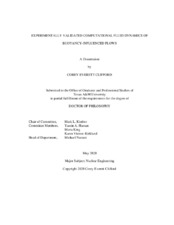| dc.contributor.advisor | Kimber, Mark L | |
| dc.creator | Clifford, Corey Everett | |
| dc.date.accessioned | 2020-12-17T14:45:13Z | |
| dc.date.available | 2022-05-01T07:13:15Z | |
| dc.date.created | 2020-05 | |
| dc.date.issued | 2020-03-31 | |
| dc.date.submitted | May 2020 | |
| dc.identifier.uri | https://hdl.handle.net/1969.1/191601 | |
| dc.description.abstract | Over the past 50 years, an industry-wide shift within the nuclear community has led to increased utilization of computational fluid dynamics (CFD) to supplement nuclear reactor safety analyses. Although several “best practice” guidelines exist for individual safety evaluations, comprehensive validation efforts against benchmark-quality experimental data must occur to ensure the accuracy of these numerical models. One such area of interest to the nuclear engineering community is the capacity of these computational models to predict heat transfer characteristics across a spectrum of buoyancy conditions. In this vein, the present investigation provides a robust assessment of 13 different Reynolds-averaged Navier-Stokes (RANS) turbulence models and their ability to predict thermal system response quantities (SRQs) in buoyancy-influenced forced and mixed convection conditions. Using validation-quality experimental data from the Rotatable Buoyancy Tunnel (RoBuT) as the basis of comparison, the predictive capabilities of each turbulence model are evaluated in both buoyancy-aided and opposed configurations. ASME standards are used to quantify numerical discretization uncertainties in the modeled results while a Monte-Carlo procedure is developed to account for input uncertainty. Generally, the collection of turbulence models fails to accurately predict thermal SRQs in the buoyancy-aided configuration while analogous errors in streamwise velocity are observed in the buoyancy-opposed orientation. Both modeling errors are attributed to improper predictions of the turbulent viscosity, which will need to be rectified prior to wide-scale adoption for nuclear reactor safety calculations.
To understand these disparities, an additional assessment of 16 different turbulence treatments – 13 Reynolds-averaged Navier-Stokes (RANS) formulations and 3 large-eddy simulation (LES) sub-grid scale models – and their ability to predict various first- and second-order system response quantities is performed on a differentially heated enclosure at a Rayleigh number of 1.58 × 10^9 . In general, most RANS models suitably replicate surface heat transfer metrics and first-order field variables; however, a few low-Reynolds-number formulations markedly misrepresent these quantities. Through a comprehensive comparison of turbulent statistics and turbulence kinetic energy budgets, these model errors are traced back to a misprediction of turbulent viscosity and direct production via buoyancy. The LES predictions from all three sub-grid scale models agree well with the corresponding experimental measurements. | en |
| dc.format.mimetype | application/pdf | |
| dc.language.iso | en | |
| dc.subject | computational fluid dynamics (CFD) | en |
| dc.subject | large eddy simulation (LES) | en |
| dc.subject | mixed convection | en |
| dc.subject | natural convection | en |
| dc.subject | Reynolds-averaged Navier-Stokes (RANS) | en |
| dc.title | Experimentally Validated Computational Fluid Dynamics of Buoyancy-Influenced Flows | en |
| dc.type | Thesis | en |
| thesis.degree.department | Nuclear Engineering | en |
| thesis.degree.discipline | Nuclear Engineering | en |
| thesis.degree.grantor | Texas A&M University | en |
| thesis.degree.name | Doctor of Philosophy | en |
| thesis.degree.level | Doctoral | en |
| dc.contributor.committeeMember | Hassan, Yassin A | |
| dc.contributor.committeeMember | King, Maria | |
| dc.contributor.committeeMember | Kirkland, Karen | |
| dc.type.material | text | en |
| dc.date.updated | 2020-12-17T14:45:14Z | |
| local.embargo.terms | 2022-05-01 | |
| local.etdauthor.orcid | 0000-0003-1539-8683 | |


